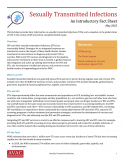- About UsOur Story, Our Team & Support Information
- What We DoAdvocacy to Achieve the End of AIDS
- Advance HIV/SRH Integration
- Advocate for Access to High-Impact Prevention
- Improve Research Conduct
- Product Innovation & Availability
- Promote Effective HIV Prevention Policy
- Strengthen Global Advocacy Networks
- Track and Translate the Field
- Our FocusInterventions to End the Epidemic
- ResourcesPublications, Infographics, Events & More
- MediaInformation & Resources for the Press
- Our BlogPrevention News & Perspective
Sexually Transmitted Infections (STIs) have a profound impact on sexual and reproductive health worldwide with serious consequences beyond their immediate impact. STIs are known to increase risk of certain cancers, adversely impact pregnancy outcomes, increase HIV risk and infertility, and more. With more than a million people acquiring a new STI every day, there is an urgent need to strengthen, scale up and make available existing interventions,while pursuing development of STI vaccines for long-term, sustainable STI prevention and control.
The World Health Organization (WHO), US National Institute of Allergy and Infectious Diseases (NIAID) and partners from around the world developed a global roadmap to advance STI vaccine development. The roadmap reflects end-to-end thinking, laying out all the important steps from pre-vaccine development through vaccine introduction—from the need and potential impact to scientific gaps, implementation and access outlook—to enable developers, donors and policymakers to make informed decisions.
Since the roadmap’s publication, much progress has been made in several overarching activities to obtain better epidemiologic data to establish the public health rationale and global market for STI vaccines, to model the theoretical impact of future vaccines, and to establish what is needed to define preferred product characteristics and encourage investment in STI vaccine development. Collaboration, coordination, communication and advocacy are essential to build on this current momentum and further catalyze vaccine development action.
What We're Reading
Featured Resources
